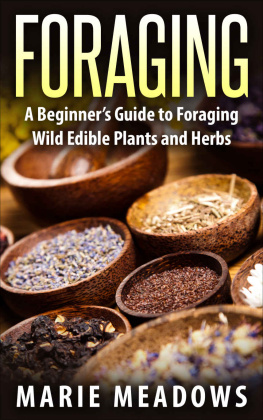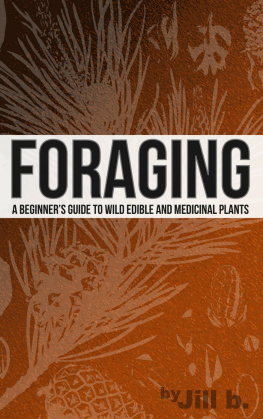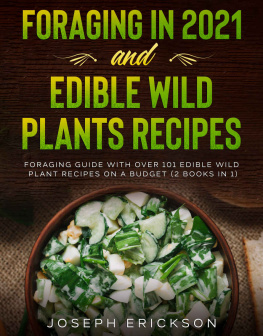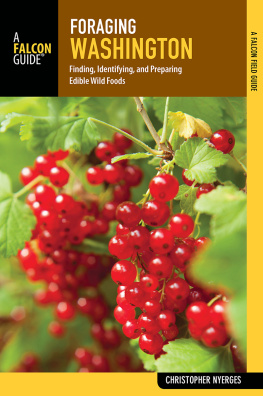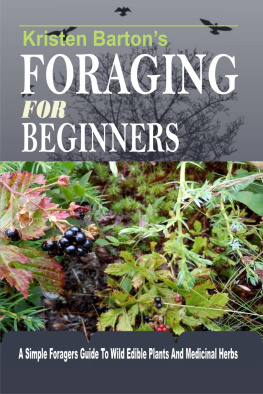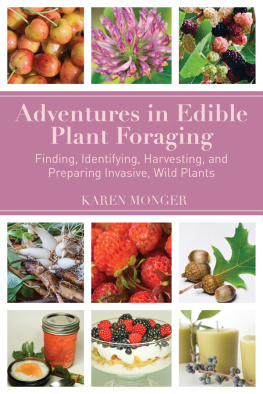Marie Meadows - Foraging: A Beginners Guide To Foraging Wild Edible Plants And Herbs
Here you can read online Marie Meadows - Foraging: A Beginners Guide To Foraging Wild Edible Plants And Herbs full text of the book (entire story) in english for free. Download pdf and epub, get meaning, cover and reviews about this ebook. year: 2015, genre: Children. Description of the work, (preface) as well as reviews are available. Best literature library LitArk.com created for fans of good reading and offers a wide selection of genres:
Romance novel
Science fiction
Adventure
Detective
Science
History
Home and family
Prose
Art
Politics
Computer
Non-fiction
Religion
Business
Children
Humor
Choose a favorite category and find really read worthwhile books. Enjoy immersion in the world of imagination, feel the emotions of the characters or learn something new for yourself, make an fascinating discovery.
- Book:Foraging: A Beginners Guide To Foraging Wild Edible Plants And Herbs
- Author:
- Genre:
- Year:2015
- Rating:5 / 5
- Favourites:Add to favourites
- Your mark:
- 100
- 1
- 2
- 3
- 4
- 5
Foraging: A Beginners Guide To Foraging Wild Edible Plants And Herbs: summary, description and annotation
We offer to read an annotation, description, summary or preface (depends on what the author of the book "Foraging: A Beginners Guide To Foraging Wild Edible Plants And Herbs" wrote himself). If you haven't found the necessary information about the book — write in the comments, we will try to find it.
Marie Meadows: author's other books
Who wrote Foraging: A Beginners Guide To Foraging Wild Edible Plants And Herbs? Find out the surname, the name of the author of the book and a list of all author's works by series.
Foraging: A Beginners Guide To Foraging Wild Edible Plants And Herbs — read online for free the complete book (whole text) full work
Below is the text of the book, divided by pages. System saving the place of the last page read, allows you to conveniently read the book "Foraging: A Beginners Guide To Foraging Wild Edible Plants And Herbs" online for free, without having to search again every time where you left off. Put a bookmark, and you can go to the page where you finished reading at any time.
Font size:
Interval:
Bookmark:
Foraging: A Beginner's Guide To Foraging Wild Edible Plants And Herbs
by
Marie Meadows
Kindle Edition
* * * * *
Published by Marie Meadows at Amazon Kindle
Foraging: A Beginner's Guide To Foraging Wild Edible Plants And Herbs
Copyright 2015 by Marie Meadows
Table Of Contents
Introduction
For thousands of years before the first seeds of agriculture were sown, our ancestors relied on the earth to naturally provide. In fact, for nearly ninety percent of human history, we survived by hunting and gathering . Even then, fire was not always easily accessible, meat not always availableat times the only way to survive was to gather all the natural food we could find. For both nourishment and medicine. To forage .
Today, only a few societies are known to use foraging techniques to sustain themselves, yet the art of foraging is neither lost nor unrewarding. Even in our modern, urban society, herbs, edible flowers, weeds, mushrooms and other plants can play an enriching role in the health of our bodies, and may mean the difference between life and death in a survival situation.
And you may not have to look as far as you may think. Chances are, your own backyard holds a plethora of nutritious plants you had no idea you could eat! As long as you can properly and safely identify these plants, you can enhance your diet, cut back on the grocery bills (plants grown in nature are much healthier for you than the hormone-filled ones you buy at the store anyway!), and enjoy nature while youre at it.
And the best part: the more you forage, the better at it youll become! Youll know the difference between the plants that are safe to eat, and the ones youd be safer to stay away from. The more you learn, the more edible plants youll find, and the more of a rewarding experience itll become.
Welcome to the Beginners Guide to Foraging Wild Plants and Herbs!
The Basics of Foraging
Before going out to forage, as with anything else, it is important to know the basics. Always pick what you are confident about. If youre not absolutely sure its safe, do not eat it! A good way to make sure the plant youre eating is safe is to:
Rinse or wash the part you are going to eat.
Test one at a timepreferably one new plant per day.
Test by rubbing the plant on your skin.
If there is no reaction, rub the plant on your lips.
If there is still no reaction, eat a small helping of the plant.
If there is never any reaction, then the plant should be safe to eat!
You should harvest only when the plant is big enough to maintain its healthy growth. The best time to harvest a plant is before it flowers, so leaf production is not negatively affected. As for the flowers themselves, they have their best flavor after the bud has appeared, but before it has opened.
And always make sure you know the laws of the area you are harvesting from and are following them carefully. Youll want to check for yourself, but generally:
On public land, do not forage where it is not permitted.
Always get permission to forage on private land.
If you arent sure about something, always get in contact with the regulatory office of the land manager to be safe.
With the basics covered, youll also need to follow the rules of foraging.
The Rules of Foraging
Here are some basic rules every forager should live by:
When you want to try a new plant, always check to be 100% sure it isnt a poisonous lookalike to an edible plant.
Make sure to never pick plants on the endangered species list. It is not only dishonorable, but illegal!
Never take all of a plant from a patch. Take only what you need and be careful when harvesting the root. The roots keep the plant alive, so only harvest if the plant is very plentiful. If in doubt, let the roots be.
Never pick in places that may have been exposed to pollution, roadsides, or sprayings from farm chemicals such as herbicides, pesticides, etc. Try to avoid foraging in places where soil may have been brought in from another location. It may have brought these harmful things with it.
Never collect from nature reserves.
Consider spreading seeds of native species where you harvest to give a little back.
And never leave behind any litter. Nature is too beautiful for that!
Now, on to the foraging!
Edible Weeds
Lets start off with one of the most easily recognizable weeds out there. It has deep roots, yellow flowers, and is often considered a pest in most gardens. You guessed it!
Dandelion (Taraxacum Officinale)
This weed gets a bad reputation, but it is amazingly nutritional, full of vitamins, minerals, and even antioxidants. One cup of raw dandelion greens contains 112% of your daily required intake of vitamin A, 535 % of vitamin K, the flowers have more beta-carotene than carrots, and you can even dry, roast, and brew the roots for a substitute for coffee!
Features: Hairless, notched, basal leaves in a rosette base over the taproot producing several stems with bright yellow flowers.
Habitat: Dandelions will grow pretty much anywhere. Youll find them in lawns all the time, and in any habitats from deep woods to tended fields, from rocky hillsides to lush lawns.
Edible Parts: Flower, leaves, and roots. They can be eaten raw or cooked, can be dried or frozen, the flowers can be made into juice, the root into a substitute for coffee, and the leaves and root can be dried and used for tea.
Nasturtium (Tropaeloum Majus)
This plant can be considered either a weed or a beautiful accessory to your garden. All of it is edible, and offers a spicy, almost peppery bite on the tongue (the spiciness can be reduced by watering well). The leaves are a great source of vitamin C, and are great for salads. The flowers are beautiful as an edible decoration.
Features: Large, smooth, mostly circular leaves with visible veins running through. The flowers are brightly colored from red to orange to yellow, with five petal, eight stamens, and a long nectar spur at the rear. The fruit has three segments with one large seed.
Habitat: Originating in the Andes from Bolivia north to Colombia, this particular species has become naturalized in parts of the United States including California, New York, Pennsylvania, New Hampshire, Massachusetts, and Connecticut.
Edible Parts: All parts are edible. The flowers are the most consumed because they can be used for decoration, and in a stir fry. They also contain the highest amount of lutein of any edible plant. The unripe seed pods can be used in spiced vinegar for a condiment or garnish.
Alfalfa (Medicago Sativa)
If youre an animal person, you might be going, Wait! That is literally horse food!
As it turns out, alfalfa is actually an underappreciated food wonder. Helpful for dozens of different health problems, especially ones caused by nutritional deficiencies, alfalfa has been used for centuries. Arabian horsemen were the first to find that it greatly benefited their livestock, giving them greater energy and performance. Well, those wonders can work for people too!
Features: Alfalfa can grow up to a meter (3.28 feet) tall, and have roots that stretch fifteen times that much. Stems have leaves clustered in threes like a clover, only more narrow and elongated, with sharp prickles in their upper part. The flowers come in clusters of ten to twenty purple flowers, bunched like that of a clover flower or small lupine.
Habitat: It is often grown for animals, but alfalfa can be found wild in meadows, near rivers, in woodlands, and along roadsides, railroads, abandoned fields, and empty lots.
Edible Parts: Leaves and shoots can be eaten either raw or cooked. The leaves can be dried for teas or soups, or ground up to bake with, and the sprouted seed can be used in salads, soups, or eaten as is as a snack. Warning: Alfalfa can trigger attacks in people with systematic lupus erythematosus.
Next pageFont size:
Interval:
Bookmark:
Similar books «Foraging: A Beginners Guide To Foraging Wild Edible Plants And Herbs»
Look at similar books to Foraging: A Beginners Guide To Foraging Wild Edible Plants And Herbs. We have selected literature similar in name and meaning in the hope of providing readers with more options to find new, interesting, not yet read works.
Discussion, reviews of the book Foraging: A Beginners Guide To Foraging Wild Edible Plants And Herbs and just readers' own opinions. Leave your comments, write what you think about the work, its meaning or the main characters. Specify what exactly you liked and what you didn't like, and why you think so.

